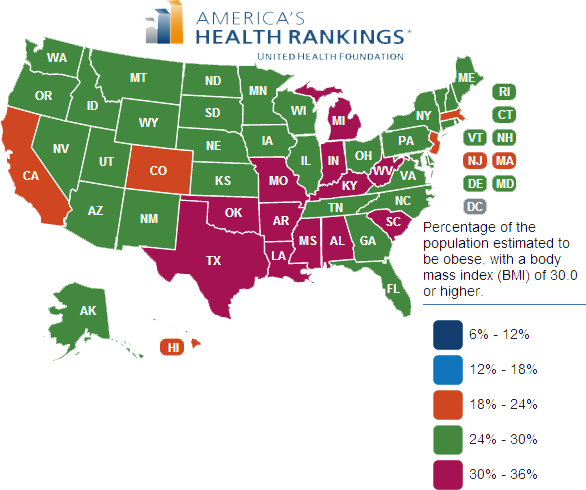Yes, We ARE Getting Healthier!

In the midst of the healthcare crisis, America’s actual health, in many ways, is improving! It’s easy to feel discouraged by the political struggles, obesity and diabetes “epidemics”. Hearing that the U.S. has a worse life expectancy than Slovenia and Chile is very disheartening. Yet, despite some huge challenges that aren’t going away, there is an upside.
The 2013 Annual Report by America’s Health Rankings® is in and the word is better than we may have expected. The longest running annual assessment of the nation’s health on a state-by-state basis, America’s Health Rankings has spent 24 years assembling health data to help us see our progress and challenges. (http://www.americashealthrankings.org)
The almost twenty-five year trend of increasing obesity appears to have leveled off since 2012. The scientists aren’t ready to predict which way the scales will tip on this one, but at least it’s not another increase. In 1990 almost thirty percent of Americans smoked. In the last year we finally edged just under twenty percent with seventeen states showing a decrease in smoking.
Healthier Hearts
 Healthier Lifestyles, Healthier Hearts
Healthier Lifestyles, Healthier Hearts
A real eye-opener is learning that cardiovascular deaths have declined 36 percent since 1990 and each year continues to see a 2-3 percent decrease. We’re also doing a better job of helping people avoid ending up in the hospital when it could have been prevented. “Preventable hospitalizations continue to decline. In 2001, there were 82.5 discharges per 1,000 Medicare enrollees; in 2013, there were 64.9 discharges per 1,000 Medicare enrollees.”
The American workplace is also becoming safer. “Occupational fatalities have declined slightly in the last 6 years from 5.3 deaths in 2007 to 3.8 deaths per 100,000 workers in the 2013 Edition. Rates have reached a 23 year low.”
Though most of the decline happened between 1990 and 1999, infant mortality is 39 percent less than it was in 1990. Though not dropping much recently, there has been no increase in recent years. At the same time though, the number of children living in poverty continues to increase with the 2013 report telling us that slightly more than one in five American children live below the poverty line.
As you look at the state-by-state maps in the report the geographic and other disparities are painfully obvious. A close to home example show us this. “The prevalence of physical inactivity varies from a high of 52.8 percent of adults aged 25 and older who did not graduate high school in Arkansas to a low of 6.7 percent of college graduates aged 25 and older in Colorado.”
While challenges remain and stats like those found in the America’s Health Rankings report can help drive the changes we will need to improve our country’s health, the progress needs to be hailed. The knowledge that we can and in fact are being successful in improving the health of populations helps empower us all. When we see that a state like Nevada can lead the nation in decreased smoking there’s motivation to do more in our own neck of the woods!
 Dr. Arloski
Dr. Arloski
The Coach’s Take Away
Many wellness coaching clients are discouraged not only by their own failure experiences, but also by the never-ending barrage of negative press that spotlights one problem after another. While a head-in-the-sand approach to life only leads to more problems, and we do need to increase our vigilance about the food we eat, etc., everyone needs to know that our country-wide wellness efforts are paying off. We talk about the client’s “self-efficacy”; their degree of belief that it is possible to positively affect their own health. Stats like America’s Health Rankings can show that there is reason to increase our collective sense of health & wellness efficacy. Positive psychology works!
 Wellness Is About The Big Picture!
Wellness Is About The Big Picture!
Coaches also need to be involved in wellness beyond the one-on-one or small group work that they do. In a company, the key to a successful wellness coaching program is for it to be part of a larger comprehensive wellness program. Such programs provide not only coaching, but education, wellness skill building, opportunities to be well (healthier food access, physical fitness access, built-in movement throughout the day, etc.), and a thorough effort at establishing a culture of wellness throughout the organization at all levels. The natural extension of all of this is community and environmental wellness. Demonstrated progress can show decision makers in both industry and government that wellness works, and most importantly, is worth funding. Coaches who care about wellness can benefit by caring about the bigger picture as well.








Only registered and logged in readers can leave comments.